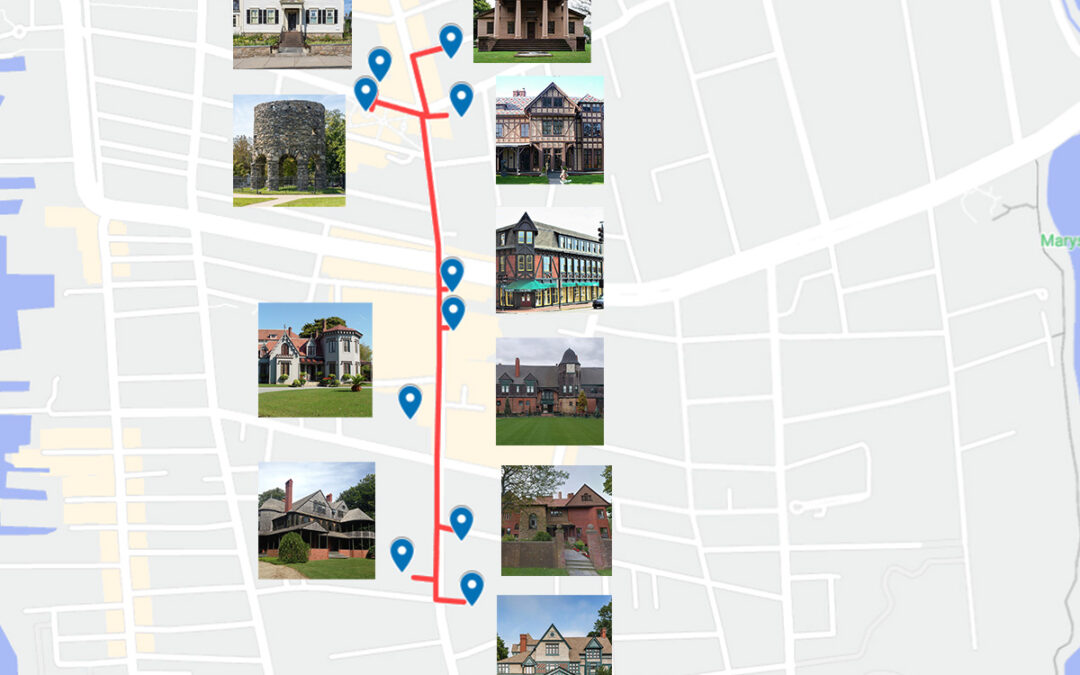The Newport Architecture Tour Map
During Newport’s occupation by the British forces from 1776 to 1779, the population of the town decreased by fifty percent, and it would never return to its status as the fifth most populated city in North America.
It was, however, blessed with a lovely climate, a collection of pre-Revolutionary war mansions, an excellent deep-water harbor, and a tradition of gentility.
In the period after The American Revolution through the early Gilded Age era, Newport became a city of traders, fishermen, and southern property owners who found Newport a comfortable place to escape the southern heat and malaria. At that time, the city was nicknamed “Carolinas Hospital” as a place to escape the south during the hot summer months. These houses, while grand and stately for their time, were far smaller than the building that would be built in the next historical period.
The city began to grow again during the federal period and by the period just before and after the American Civil War, noted architects from New York like Richard Upjohn were designing beautiful mansions, which were widely published in design books and architectural journals. This period was largely defined by the work of Newport Architect, George Champlin Mason Sr. (1820-1894), and New York Architect Richard Morris Hunt (1827-1895) who summered in Newport and built many of his early projects here including the J.N.A. Griswold House (1865) and the Travers Block (1890), which were both designed in the “Stick Style”.
This period also included many of the Shingle Style masterpieces by the firm of McKim, Mead, and White, which would become the dominant architectural force of the late Gilded Age which continued until the First World War (or the Great Depression). These buildings include The Newport Casino (1879) and the Isaac Bell House (1882) which, in retrospect, are among the most inventive, confident, and purely American architecture of this nation’s history. Vincent Scully aptly called it “The Architecture of the American Summer” and it remains so up to the present day.
Here is a compact architectural tour with brief descriptions and histories of the various buildings to help visitors and residents alike better know and appreciate these Bellevue Avenue treasures.
BELLEVUE AVENUE WALKING ROUTE PART 1 (20 min)
16 – Redwood Library
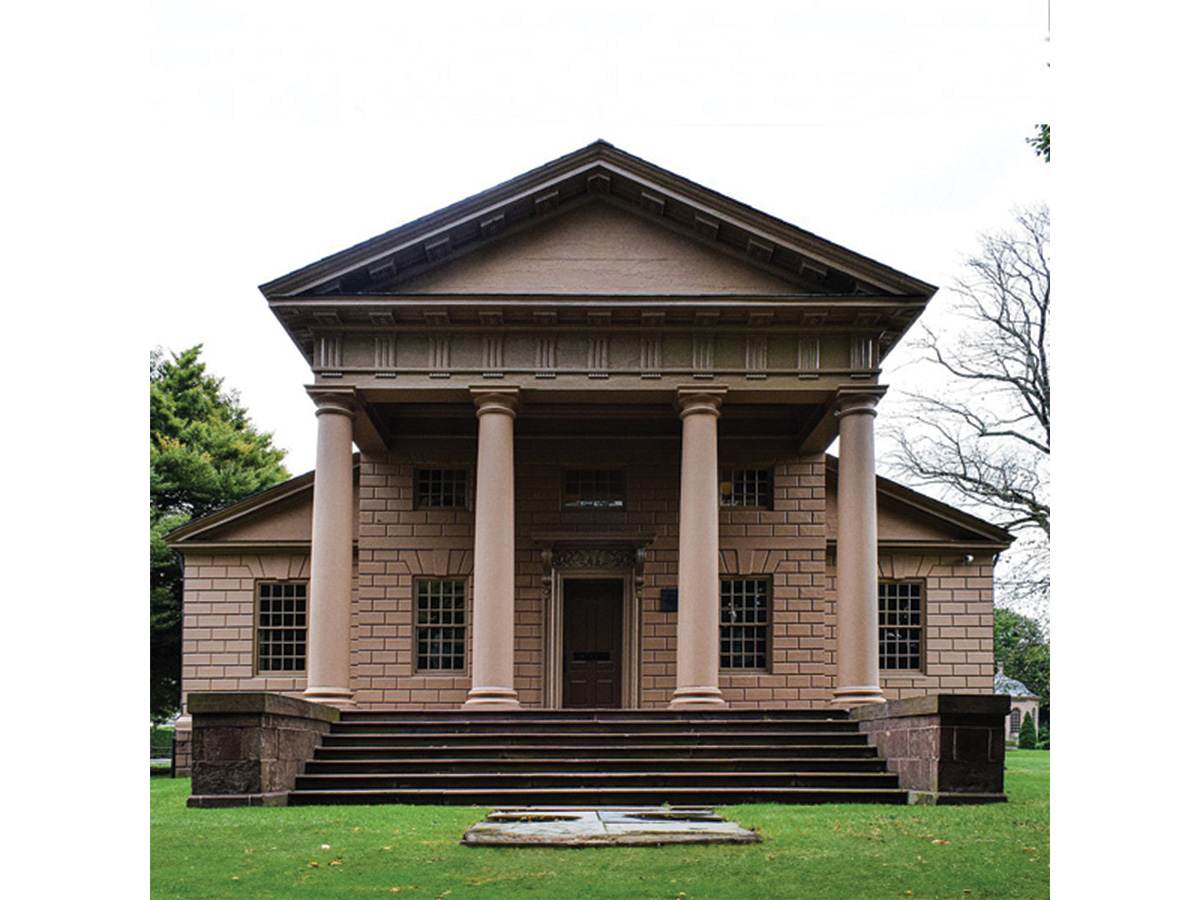
Redwood Library (Peter Harrison, 1748)
- The Redwood Library and Athenaeum is America’s first purpose-built library, and the oldest continuously operating in its original location.
- Housed in the earliest public Neoclassic building in the U.S., and containing Rhode Island’s first art gallery (1875), it has functioned for nearly three-hundred years as Newport’s intellectual core, a humanities center and civic learning hub styled after ideals of ancient Athenian culture and philosophy.
- Created as a community endeavor by its namesake and forty-six original proprietors—what has been described as the single “greatest act of philanthropy in colonial America.”
- Redwood Library was the first major architectural commission of Peter Harrison. His Doric design is considered the first such use in the New World. The model for the Redwood Library, a Roman Doric temple with portico and wings, was probably derived from the headpiece of Book IV of Edward Hoppus’ 1735 edition of Andrea Palladio’s architecture.
- The building is crafted of wood “rusticated” to look like stone. This was done to make use of native materials, while imitating the look of stone that was in accordance with the current English Palladian taste.
- The Harrison Room is the main room in the original Redwood Library building, designed by Peter Harrison. This room has been in continuous use as a library since its completion in 1750. The Harrison Room was only lit by natural light from the windows, since any type of fire or coal-based lighting would pose a threat to the books.
- The Reading Room was the first expansion of the library, opened in July of 1859. George Snell of Boston, the architect for the new addition, had the practical idea to create two long narrow gallery rooms alongside the Harrison Room, connecting the new Reading Room with the littles wings.
- The second expansion to the library was the addition of the Delivery Room. George Champlin Mason was the architect of this extension, built in 1875. Like his predecessors, Mason designed the addition to harmonize with the original 18th-century building. The exterior façade is covered with olive stone cut to conform with Peter Harrison’s 1747 designs.
It was added as a National Historic Landmark on October 9th, 1960.
17 – J.N.A Griswold House
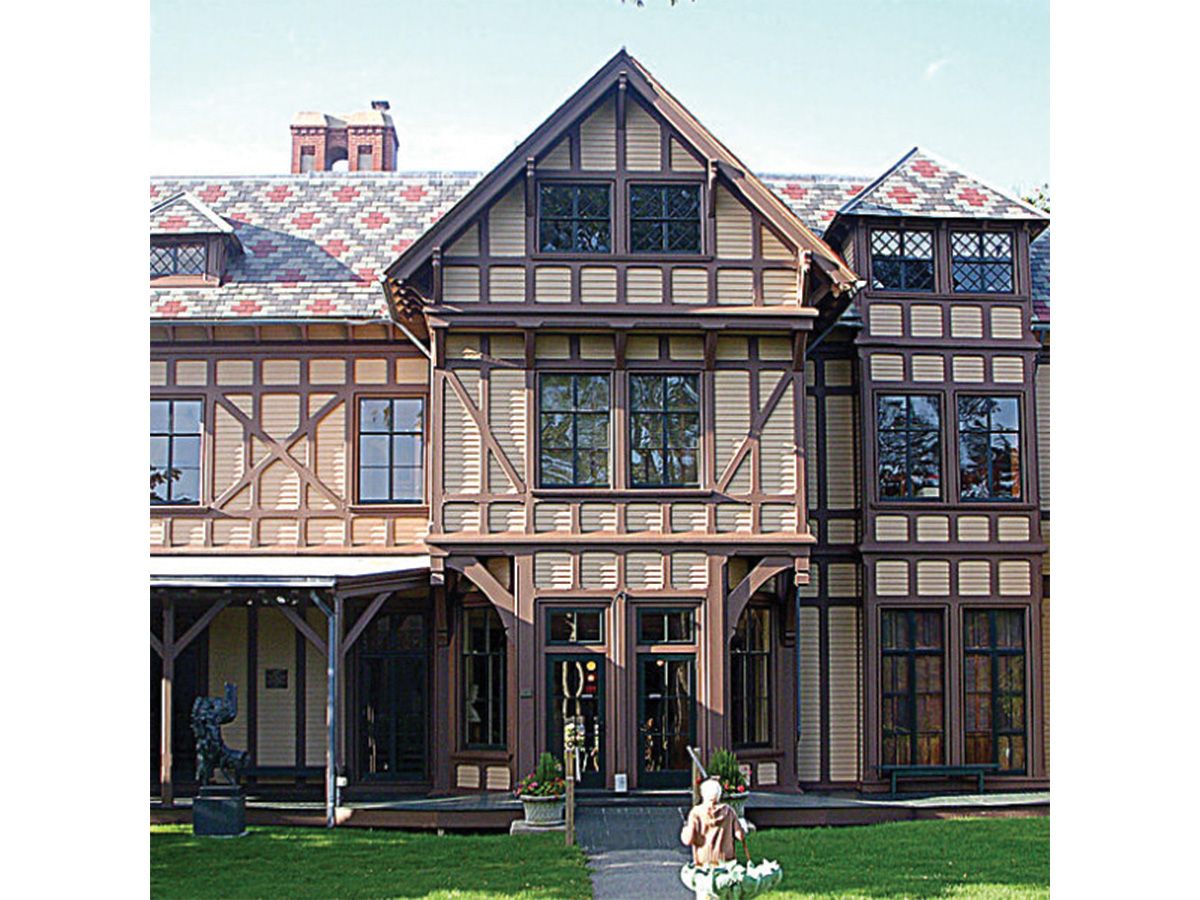
J.N.A. Griswold House (Richard Morris Hunt, 1861-64)
- Prototype of the first “Stick Style” structures as referred to by Vincent Scully.
- A 2.5-story wood-frame structure, set on a granite foundation and wrapped in a surface of clapboards and half timbering, with deep shading porches, supported by simple posts and braces.
- Interior spaces pushing and pulling at the elevations, creating deep recesses, engaged towers, bays dormers, and offset wall planes.
- It has a complex roofline, whose main mansard section is pierced by numerous gable and dormer sections. The roof is finished with bands of polychrome slate and is enhanced by chimneys with concrete caps and decorative panels. There are numerous balconies sheltered by deep eaves, with gable ends decorated with applied Stick style woodwork. An expansive veranda wraps around the southern and western sides of the house, with an elaborately decorated port-cochere on the north side.
The house was added to the National Register of Historic Places in 1971, designated a national historic landmark on May 16th, 2000.
18 – Newport Tower
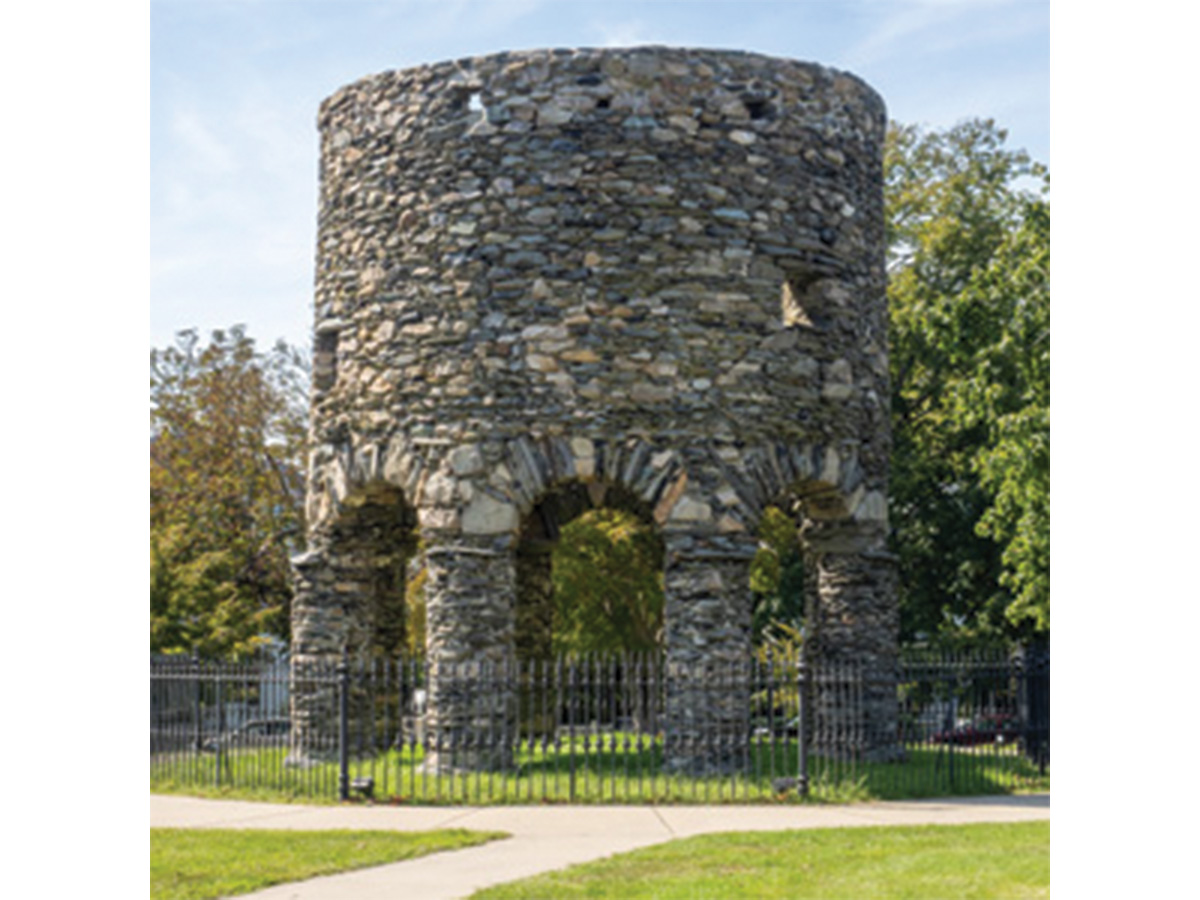
Newport Tower (Unknown, Mid-17th Century)
- Probably the oldest existing structure in Newport.
- It was among the earliest historic attractions in Newport.
- It is supported by eight cylindrical columns that form stone arches, two of which are slightly broader than the other six. Above the arches and inside the tower is evidence of a floor that once supported an interior chamber.
- Various theories about its creation have ranged from Knights Temples to Vikings, but it is most likely the remnants of an early Colonia Era windmill.
19 – John Tillinghast House

John Tillinghast House (1760)
- A 2 ½ story wood-frame structure, high quality example of Georgian architecture.
- The home of John Tillinghast (1690-1777), a representative to the RI General Assembly in 1744 and 1749, a wealthy merchant and ship owner who became heavily involved in privateering.
- During the American Revolution, General Nathaniel Greene was quartered in this house. Greene was born to a Quaker family in what is now Warwick, RI, but because of his interest in military affairs, the Quaker meeting to which he belonged disowned him
- This house reveals the international nature of the War for Independence, which saw French forces joining with the Americans and German mercenaries fighting with the British.
BUS RIDE
20 – Travers Block

Travers Block (Richard Morris Hunt, 1870-71)
- Designed by Richard Morris Hunt, the 2.5 story wood and brick façade, picturesque surface treatment of European-derived half timbering resulted in novel-looking buildings.
- On the first story, large windows open into a row of small shops, then as now sheltered by deep overhanging awnings to protect merchandise and promenading shoppers. Hunt wrapped the second level in a skin of ornamental half timbering, the grid of brace work segmenting the brick walls and windows to achieve an effect that is reminiscent of historical structures.
- The whole of his composition is capped with a roofline array of bracketed eaves, cross gables, and dormers—adding visual delight but also making the third story more habitable as rental bachelor apartments.
- He used the same ornamental grid of brace work he used to develop his residential work in 1860s, further developing the style.
- It visually symbolized the population of sophisticated wealth and status of land development.
The block was added to the National Register of Historic Places in 1976.
21 – Newport Casino

Newport Casino (McKim, Mead & White, 1879-1881)
- Often considered the first true “Shingle Style” building.
- The Newport Casino complex was built in only six months and was never meant to refer to gaming and gambling. The word casino traces its origins to the Italian word casa and refers to a small country villa, summerhouse, or social club.
- It was designed in the Shingle style by the newly formed firm of McKim, Mead & White. The Newport Casino was the firm’s first major commission and helped to establish the firm’s national reputation. Built as a social club, it included courts for both lawn tennis and court tennis, facilities for other games, such as squash and lawn bowling, club rooms for reading, socializing, card-playing, and billiards, shops, and a convertible theater and ballroom. It became a center of Newport’s social life during the Gilded Age through the 1920s.
- The structure combines shingle, stone, and brick to evoke an English design. Gables, tall chimneys, small windows, and open-air porches complete the building’s architectural aesthetic.
- The complex, which was the site of the earliest American lawn tennis championships, now houses the International Tennis Hall of Fame. The Newport Casino also hosted the first Newport Jazz Festival in 1954.
The casino was added to the National Register of Historic Places in 1970 and was designated a National Historic Landmark on February 27th, 1987.
BELLEVUE AVENUE WALKING ROUTE PART 2
22 – Kingscote Mansion
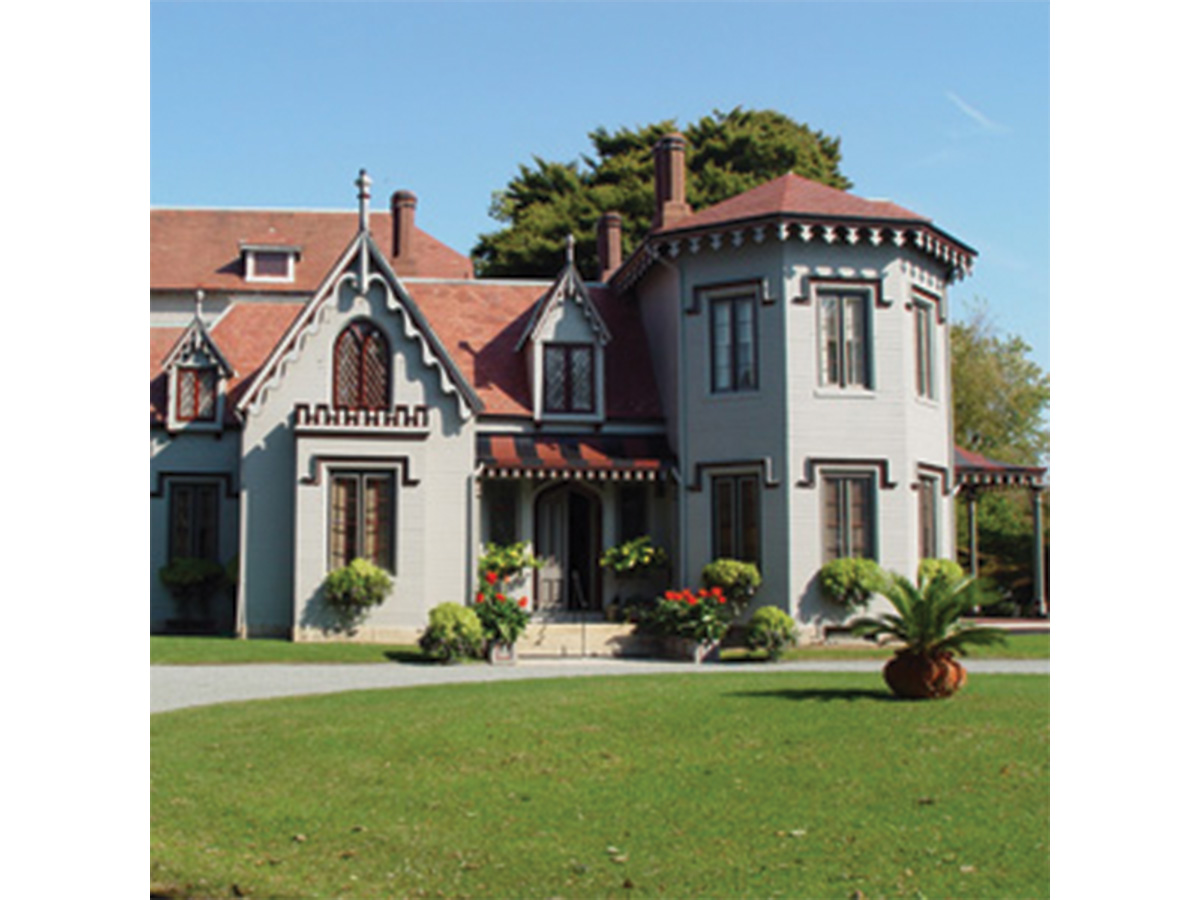
Kingscote Mansion (Richard Upjohn, 1849)
- It was designed as The George Noble Jones house by noted New York architect, Richard Upjohn.
- Its appearance marked the beginning of the “cottage boom” that distinguished the town for the design of picturesque houses throughout the 19th
- The general effect was a romantic- fanciful composition of towers, windows, gothic arches and porch roofs inspired by medieval tournament tents.
- House was sold in 1864 to China Trade merchant William Henry King and was greatly enlarged and renovated by McKim, Mead and White in 1882.
The Kingscote House was declared a National Historic Landmark in 1996.
25 – The LeRoy King House
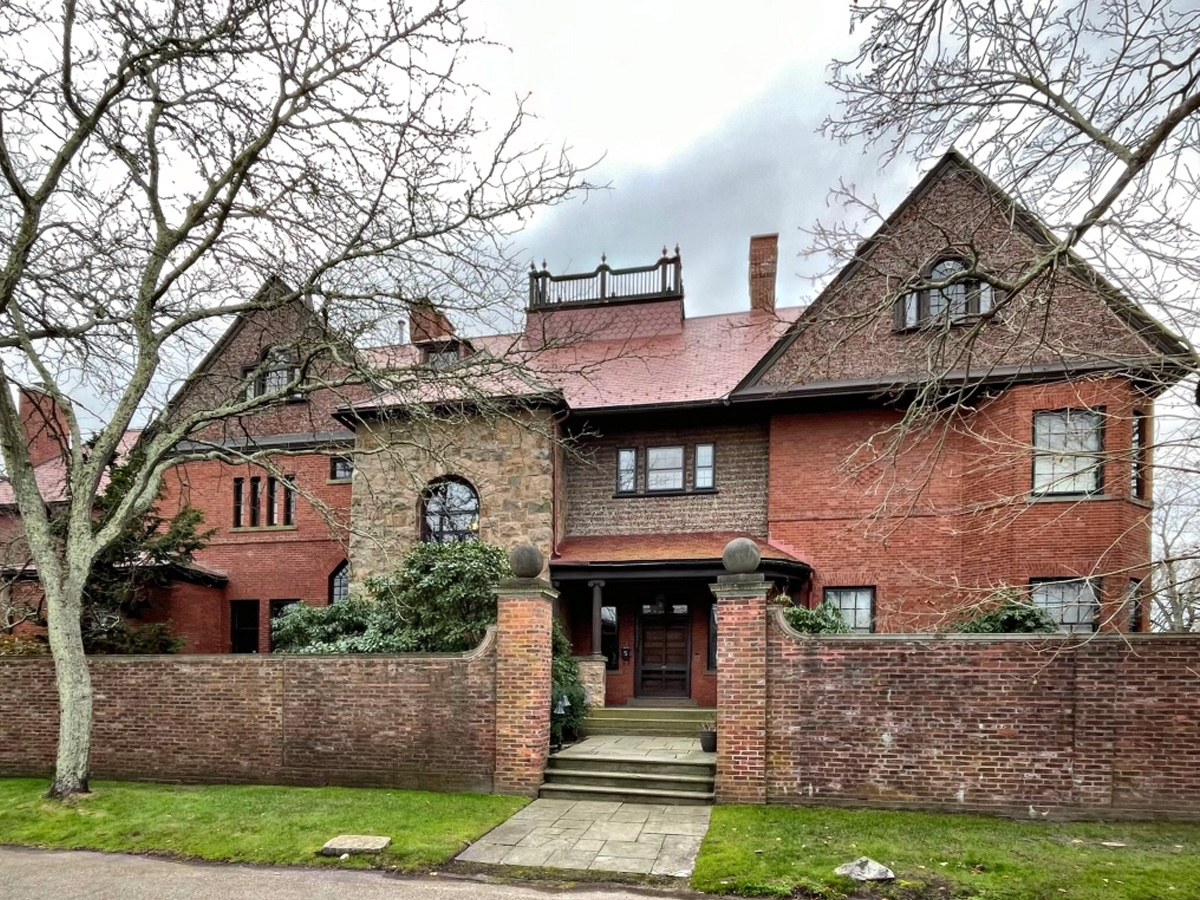
The LeRoy King House (McKim, Mead and White 1885-86)
- The house was created for LeRoy King, a wealthy merchant who was the brother of David King and son of Edward King.
- The house marked a subtle departure from their earlier informal Shingle Style projects in Newport showing a new focus on classical symmetry, proportion, and masonry construction.
- The use of materials further underscores the transitional nature of this specific building design. The foundation utilizes traditional brick and dressed stone as opposed to the more rusticated stone of the Shingle Style.
- The house incorporated cutting-edge technology for its time, including electric lighting and a central heating system.
- It illustrates a midpoint in the transition in Newport from the informal Shingle Style of the early 1880’s to the hyper-formal work of the “High Gilded Age” just 15 or 20 years later.
23 – Charles H. Baldwin House

Charles H. Baldwin House (Potter & Robertson, 1877-1878)
- Designed by Robert Robertson in the Queen Anne Revival style for Adm. Charles Baldwin.
- Stands as a significant step in evolution of American architecture during the 19th century
- The polychromy of half timbers is juxtaposed with planes of natural cedar shingles.
- Transition style between Queen Anne Revival & emerging Shingle Style.
- Asymmetrical massing, prominent gables and a wraparound porch with turned columns, a combination of brick, clapboards and shingles on the exterior, and a shift toward more informal and picturesque aesthetic.
- The spacious interior reflected emphasis on social gatherings of the Gilded Age
The Charles H. Baldwin House was added to the National Register of Historic Places on May 6th, 1971, and was designated a National Historic Landmark on December 8th, 1972.
24 – Isaac Bell House

Isaac Bell House (McKim, Mead & White, 1882-1883)
- This is among the many shingle style cottages designed by MMW in the 1880-1886 period.
- Originally known as “Edna Villa,” this Shingle Style architecture contains many Queen Anne and Colonial Revival idioms throughout its design.
- The facades are unified by shingled skin, sometimes with bands of cut patterns, wraparound porches, simple window and trim detail, and tall tower volumes.
- Japanese architecture inspired the floor plans, with flowing space that allows rooms to be used together or separately. Japanese architecture also prompted decorative details, including bamboo-shaped porch supports and interior hardware details.
- The intimate and organic decoration of the house stands in contrast to the grandiose monumental houses along the rest of Bellevue Avenue.
- Vincent Scully hypothesized that published plans and elevations of the house had a major impact on the work of Frank Lloyd Wright and other architects around the country, making it one of the most influential buildings in Newport.
The Isaac Bell House was declared a National Historic Landmark on September 25th, 1997.
23 – Charles H. Baldwin House

Charles H. Baldwin House (Potter & Robertson, 1877-1878)
- Designed by Robert Robertson in the Queen Anne Revival style for Adm. Charles Baldwin.
- Stands as a significant step in evolution of American architecture during the 19th century
- The polychromy of half timbers is juxtaposed with planes of natural cedar shingles.
- Transition style between Queen Anne Revival & emerging Shingle Style.
- Asymmetrical massing, prominent gables and a wraparound porch with turned columns, a combination of brick, clapboards and shingles on the exterior, and a shift toward more informal and picturesque aesthetic.
- The spacious interior reflected emphasis on social gatherings of the Gilded Age
The Charles H. Baldwin House was added to the National Register of Historic Places on May 6th, 1971, and was designated a National Historic Landmark on December 8th, 1972.
Ross Cann, RA, AIA, LEED AP, is an author, historian, teacher and practicing architect living and working in Newport, RI. He holds degrees in Architecture and Architectural History from Yale, Cambridge, and Columbia Universities. He is a Leadership in Energy and Environmental Design Accredited Professional.
